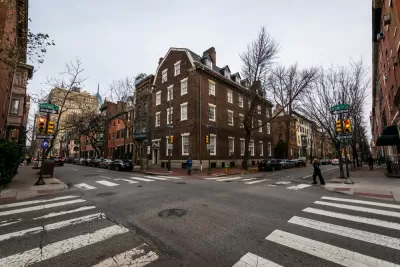The Philadelphia City Council is expected to approve new zoning for Society Hill over the objections of the Planning Commission and city planning staff.

Proposed zoning changes for a tony part of Philadelphia would impose new height limits and require more parking for new development, despite the recommendations of planning staff and vocal criticisms from the media.
"Philadelphia City Council is poised to approve new, restrictive zoning rules for Society Hill this week, over the objections of critics, including the Planning Commission, who said the bill will thwart the city's goals on affordable housing, historic preservation and climate change," reports Pat Loeb.
Explaining the specifics of the zoning changes proposed for Society Hill, Loeb writes:
The bill would limit building height in the neighborhood, which runs from the Delaware River to 8th Street, between Walnut and Lombard. In some parts of it, buildings could not exceed 45 feet, limiting how much housing could be built there, decreasing the chances for creating mixed income units.
It also increases the number of parking spaces required for new development despite the city's goal of reducing private car use to relieve congestion, improve safety and fight climate change.
Clearly, the zoning changes expected for approval by the Philadelphia City Council run afoul of most of contemporary planning thought about the racist and discriminatory effects of exclusionary zoning and the negative financial and environmental consequences of parking regulations. Society Hill has been accused of playing by its own rules before, as described in detail by Inga Saffron, Pulitzer Prize-winning architecture critic for the Philadelphia Inquirer, in a column published in November 2019.
FULL STORY: City Council to vote on new zoning rules for Society Hill

Manufactured Crisis: Losing the Nation’s Largest Source of Unsubsidized Affordable Housing
Manufactured housing communities have long been an affordable housing option for millions of people living in the U.S., but that affordability is disappearing rapidly. How did we get here?

Americans May Be Stuck — But Why?
Americans are moving a lot less than they once did, and that is a problem. While Yoni Applebaum, in his highly-publicized article Stuck, gets the reasons badly wrong, it's still important to ask: why are we moving so much less than before?

Using Old Oil and Gas Wells for Green Energy Storage
Penn State researchers have found that repurposing abandoned oil and gas wells for geothermal-assisted compressed-air energy storage can boost efficiency, reduce environmental risks, and support clean energy and job transitions.

Poorest NYC Neighborhoods Pay Price for Delivery Boom
The rise of ‘last-mile’ e-commerce warehouses — and their attendant truck traffic and air pollution — is disproportionately impacting the most historically disadvantaged parts of the city.

Greening Oakland’s School Grounds
With help from community partners like the Trust for Public Land, Oakland Unified School District is turning barren, asphalt-covered schoolyards into vibrant, green spaces that support outdoor learning, play, and student well-being.

California Governor Suspends CEQA Reviews for Utilities in Fire Areas
Utility restoration efforts in areas affected by the January wildfires in Los Angeles will be exempt from environmental regulations to speed up the rebuilding of essential infrastructure.
Urban Design for Planners 1: Software Tools
This six-course series explores essential urban design concepts using open source software and equips planners with the tools they need to participate fully in the urban design process.
Planning for Universal Design
Learn the tools for implementing Universal Design in planning regulations.
Heyer Gruel & Associates PA
City of Moreno Valley
Institute for Housing and Urban Development Studies (IHS)
City of Grandview
Harvard GSD Executive Education
Salt Lake City
NYU Wagner Graduate School of Public Service
City of Cambridge, Maryland



























